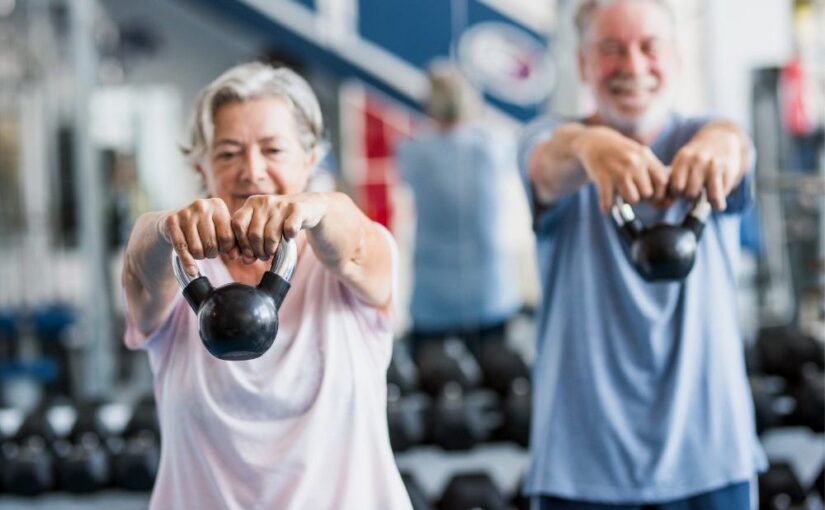As we age, maintaining strength, flexibility, and balance becomes increasingly important for overall health and quality of life. Many seniors are turning to kettlebells as a viable option for strength training. But are kettlebells really suitable for older adults? Let’s explore the benefits, considerations, and guidelines for seniors using kettlebells, along with a sample exercise routine.
Benefits of Kettlebell Training for Seniors
1. Improved Strength
Kettlebells engage multiple muscle groups, helping seniors build overall strength. Exercises like swings, deadlifts, and presses enhance functional strength, making daily activities easier.
2. Enhanced Balance and Coordination
Kettlebell training requires stability and control, improving balance and coordination. This is particularly beneficial for seniors, as it helps reduce the risk of falls.
3. Increased Flexibility
Many kettlebell exercises involve a range of motion that promotes flexibility, contributing to better mobility and joint health.
4. Cardiovascular Benefits
Kettlebell workouts can elevate heart rate, providing a cardiovascular component to strength training, which helps maintain heart health and overall fitness.
5. Convenience
Kettlebells are compact and can be used at home or in the gym, allowing seniors to incorporate strength training into their routine without needing extensive equipment.
6. Adaptability
Kettlebells come in various weights, enabling seniors to start with lighter options and progress as their strength increases. Many exercises can also be modified to suit individual fitness levels.
Considerations for Seniors Using Kettlebells
1. Consulting a Professional
Before starting any new exercise program, seniors should consult with a healthcare provider or fitness professional, especially if they have existing health conditions or injuries.
2. Focus on Form
Proper technique is crucial to avoid injuries. Seniors may benefit from working with a certified trainer who can guide them in mastering kettlebell movements.
3. Start Slow
Beginners should start with lighter weights and simpler exercises to build confidence and ensure they are comfortable with the movements before progressing to more complex routines.
4. Listen to Your Body
It’s essential for seniors to pay attention to how their bodies respond to kettlebell training. Any discomfort or pain should be addressed immediately, and modifications should be made as necessary.
5. Incorporate Rest
Adequate rest days are important for recovery, especially for older adults. A balanced routine should include rest to prevent overuse injuries.
Sample Kettlebell Exercise Routine for Seniors
This routine can be performed 2-3 times a week, allowing a day of rest between sessions. Always start with a light warm-up to ready your muscles.
Warm-Up (5-10 minutes):
- March in place or walk briskly
- Arm circles
- Gentle torso twists
Kettlebell Routine:
1. Kettlebell Deadlifts
- Sets: 2-3
- Reps: 10-12
- Stand with feet hip-width apart and kettlebell between your feet. Bend at the hips and knees, keeping your back straight, to grasp the kettlebell. Stand up, squeezing your glutes at the top.
2. Kettlebell Goblet Squats
- Sets: 2-3
- Reps: 10-12
- Sustain the kettlebell close to your chest with both hands. Squat down while maintaining your back straight and chest up. Rise back to standing.
3. Kettlebell Rows
- Sets: 2-3
- Reps: 10-12 per arm
- Bend slightly at the hips with a kettlebell in one hand. Pull the kettlebell toward your waist, keeping your elbow close to your body. Switch arms after completing the set.
4. Kettlebell Swings
- Sets: 2-3
- Reps: 8-10
- Stand with feet spaced shoulder-width apart and kettlebell in both hands. Hinge at the hips to lower your body, then swing the kettlebell between your legs. Use your hips to propel it forward to shoulder level.
5. Kettlebell Presses
- Sets: 2-3
- Reps: 8-10 per arm
- Keep the kettlebell at shoulder height with one hand. Press it overhead, extending your arm fully. Lower it back to shoulder height and switch arms.
Cool Down (5-10 minutes):
- Stretching exercises focusing on major muscle groups
- Deep breathing to relax and lower heart rate
Conclusion
Kettlebells can be an excellent addition to a senior’s fitness routine, offering numerous benefits, including improved strength, balance, and flexibility. With proper guidance, technique, and a focus on safety, seniors can enjoy the advantages of kettlebell training with confidence. By incorporating kettlebells into their routine and following a well-structured exercise plan, seniors can enhance their overall health and well-being, leading to a more active and fulfilling lifestyle.
Frequently Asked Questions (FAQ)
Yes, kettlebells are safe for seniors when performed with correct technique and suitable weight selection. It’s essential to start with lighter weights, focus on technique, and consult a healthcare provider before beginning a new exercise routine.
Kettlebells provide a range of benefits, such as increased strength, improved balance and coordination, greater flexibility, and better cardiovascular fitness. These exercises help seniors maintain independence and overall well-being.
Absolutely! Kettlebell exercises demand balance and control, helping to enhance coordination and overall stability. This may help lower the chance of falling, a frequent concern among older adults.
Seniors should aim to use kettlebells 2-3 times a week, with rest days in between to allow muscles to recover. It’s essential to pay attention to how your body feels and avoid pushing too hard, particularly when you’re just beginning.
For beginners, focus on simple exercises like kettlebell deadlifts, goblet squats, and kettlebell rows. These exercises target major muscle groups and help build strength gradually, with less risk of injury.
Essential Gear to Get Started
To make the most of your kettlebell workouts, it’s helpful to have a few basic items on hand. Below are some recommended products to support your training, keep you comfortable, and help you stay hydrated—perfect for seniors starting or continuing their fitness journey.
Kettlebells
Start with a light to moderate kettlebell (5–15 lbs) for safe and effective workouts. Great for building strength, balance, and endurance.
Exercise Mat
A cushioned, non-slip mat provides support for warm-ups, cool-downs, and floor exercises.
Sports Water Bottle
Stay hydrated during your workout with a durable, BPA-free water bottle. Easy to grip and carry.
Affiliate Disclaimer:
The links above are affiliate links. If you purchase through these links, we may earn a small commission at no extra cost to you.

